Introduction
Software
Applications
Detectors
GM-10
GM-45
GM-90
Accessories
Test Source
Battery Box
Coincidence Box
Anti-Coincidence
GMI Interface
Air Sampler
Download
Linux
Users Group
Interfacing
Raspberry Pi
Random Numbers
Safety Uses
Radiation Info
Specifications
FAQ
Articles
Experiments
Rad Map
Links
Secure Order
Detectors
Contact
Air Sampler for GM-45 Geiger Counter Radiation Detector
The air sampler consists of a fan and filter. Air is drawn through the filter, and radioactive materials are captured on the filter surface. The filter faces the GM-45 geiger counter, which then detects the radiation. The Air Sampler in effect increases the sensivity of the GM-45 geiger counter, allowing it to detect much smaller changes in radiation levels due to radioactive materials in the air. These materials include decay products from radon and other natural radiation sources, as well as nuclear fallout.
Buy the Air Sampler for just $69

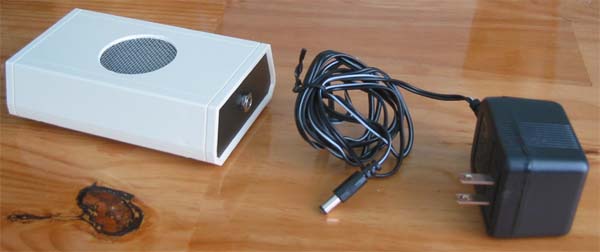
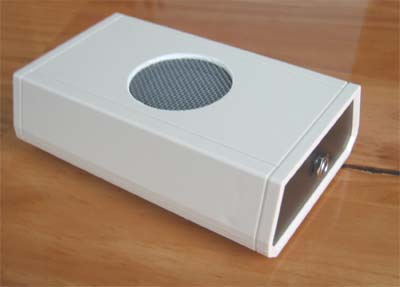
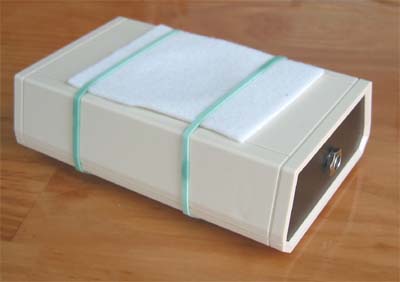
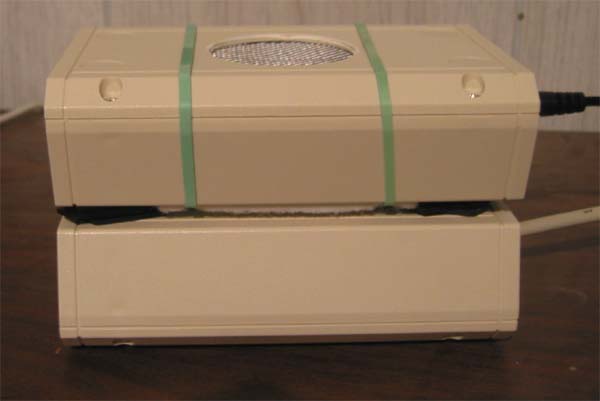
As an example, here are some details about detecting the presence of radon:
Radon is an inert gas, which is radioactive. It has a half life of about 4 days, and is often found in basements and homes, as it seeps in through openings and cracks in the foundation. It goes through a long decay process until it finally becomes stable (non radioactive), emitting radiation at each decay stage along the way. These other radioactive isotopes, along the way, are small particles, radioactive versions of lead, bismuth, polonium. These particles float in the air, where they can land on objects, or be inhaled, often then being deposited in the lungs, where they can cause lung cancer.
The Air Sampler attachment for the GM-45 allows you to install a filter directly in front of the GM-45 detector window. The GM-45 is a geiger counter detector with a large window, able to detect alpha, beta, and gamma radiation, making it ideal for detecting radon. The fan built into the unit pulls air through the filter, depositing radon decay products on the face of the filter. This essentially greatly amplifies the signal seen on the GM-45. As shown in the graph below, a nominal count rate of around 70 CPM is amplified to around 4000 CPM, a gain of around 57 times. The actual increase in readings from radon daughters is even much higher, as will be explained below.
Note that the GM-45 does not directly read out radon levels in pCi/L. However it can be used as a tool for experiments to show that radon is present, and to indicate that further testing using an EPA approved device may be required.
Take a look at the section on Radioactive Dust on this page for more details about radon.
The blue line is the data from the GM-45 without an air sampler, the red line is from the other GM-45, with an air sampler. Both units are sitting within a few feet of each other in a basement room. Due to the large difference in readings, two different Y axis are used. The one on the left of the graph, going from 0 to 100 CPM (counts per minute) is for the GM-45 only (blue graph) and the one on the right, going from 0 to 4500 CPM, is for the GM-45 with the air sampler (red graph).
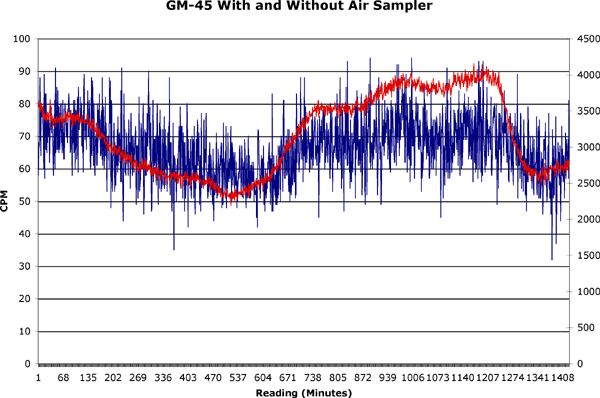
In this second graph, we've smoothed the data, so that there are less variations due to statistical noise, allowing the real variations in radon levels to be seen. Due the random nature of radioactive decay, there are always variations in readings. As the measured activity increases, this variation decreases in a relative (percentage) way. That means that if we can increase the count rate, we can decrease the apparent variation from reading to reading, which is why the red curve, the one from the GM-45 with the air sampler, looks so much more smooth.
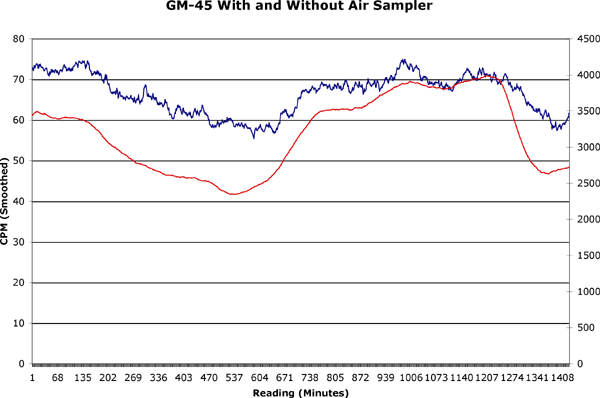
Not all of the radiation measured is from radon and daughter products, however. Some of it is from other background radiation sources, much of it is from cosmic rays, produced in outer space. Only the readings from radon and decay products are amplified by the air sampler, the cosmic ray contribution stays the same. So, it can be estimated and removed from the readings.
Two things were done to produce the following graph: First, a small multipler was applied to reduce the readings from the unit with the air sampler, to compensate for the gain (increase) in readings it provides. Second, the estimated reading from cosmic rays was added back in. This can only be an approximation, and must assume that background from cosmic and other sources remains constant, which is a fair compromise.
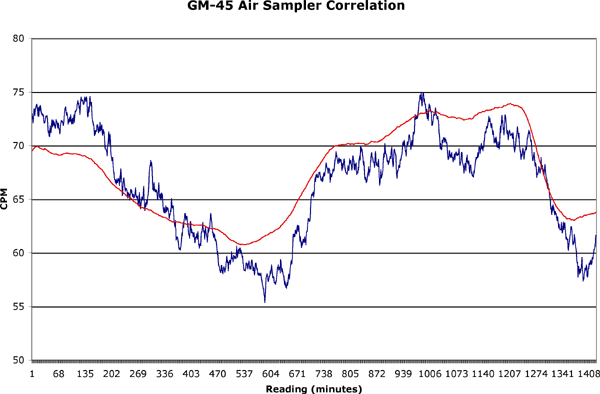
Ideally, the two graphs would now lie on top of each other. They don't exactly, but they are close. There are reasons for this, namely the cosmic ray and other background values are not exactly constant, and the radon daughters on the air sampler filter decay with various half lives, so there are always short time shifts between the readings. But the two curves are very close. Certainly close enough to give us confidence in what we are doing.
In this case, a background value for cosmic rays and other such radiation of 42 CPM was used. The multipler for the air sampler data used was 0.008. The apparent gain of the air sampler is the reciprocal of this, or 1/0.008 which is 125. So the apparent gain in readings from radon and its decay products is 125. This is of course a huge number, which is why using the air sampler makes observing even small variations in radon readings so easy. They are greatly amplified, and the constant reading from cosmic rays is greatly reduced in a relative way.
Go back to the first graph, and compare the two curves. While the radon variations are visible in the blue graph of GM-45 only data, they are difficult to see in the statistical noise, while the variations in the red curve, from the geiger counter with the air sampler, stand out and are obvious.
When the fan is shut off, the radon daughters on the filter continue to decay, with no new daughters being deposited. This results in the characteristic decay curve of the radon daughters, dominated by Lead-214 (27 minute half life) and Bismuth-214 (20 minute half life). This is clearly shown in the first graph.
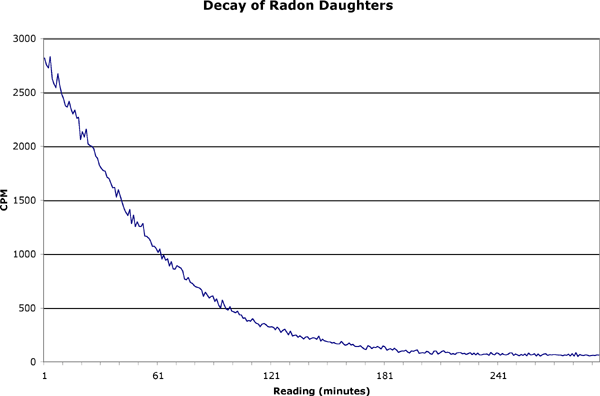
This second graph is the same data, with a logarithmic y axis. The decay portion is not
a perfectly straight line, due to the fact that two daughters are decaying, each with slightly
different half lives.
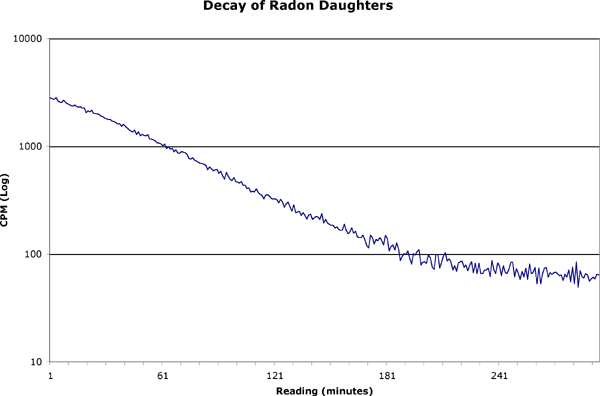
Some other interesting experimental results are available
here
The Air Sampler is for use with the GM-45 detector, both RS-232 and USB versions.
Shipments within the USA and Canada include the power supply, outside the USA/Canada,
the buyer is responsible for supplying regulated 12 volts DC. Also included are five pieces of
filter. The user needs to supply a spacer to go between the Air Sampler and the GM-45, various
materials can be used such as small pieces of wood, plastic, etc. Experimentation can be used to
find the ideal air gap for your purposes, we find around 1/4" (6 mm) works well.